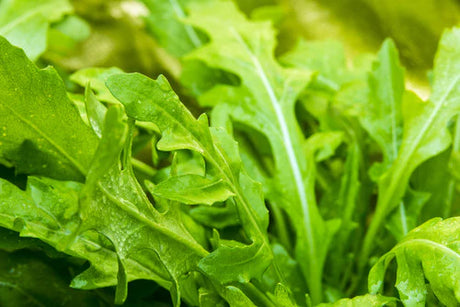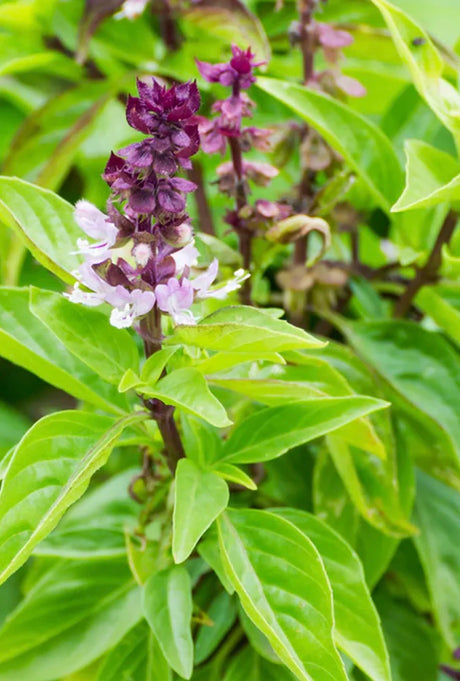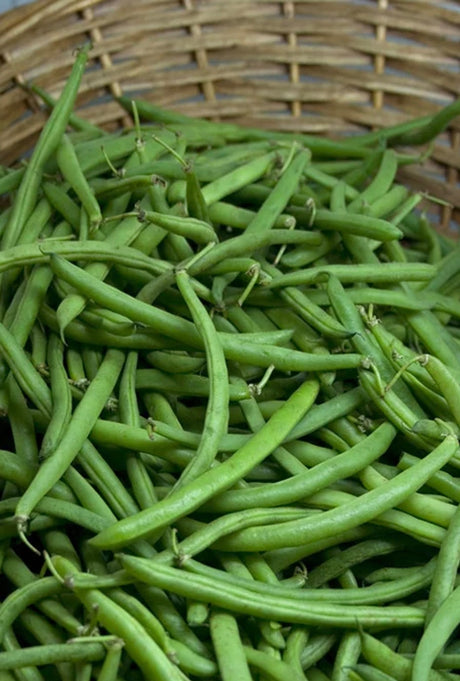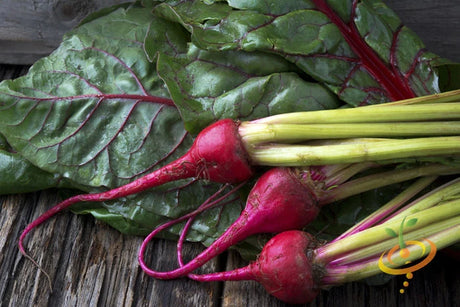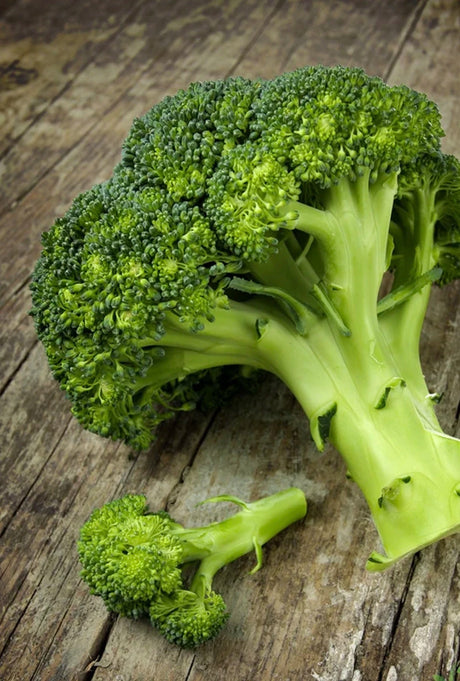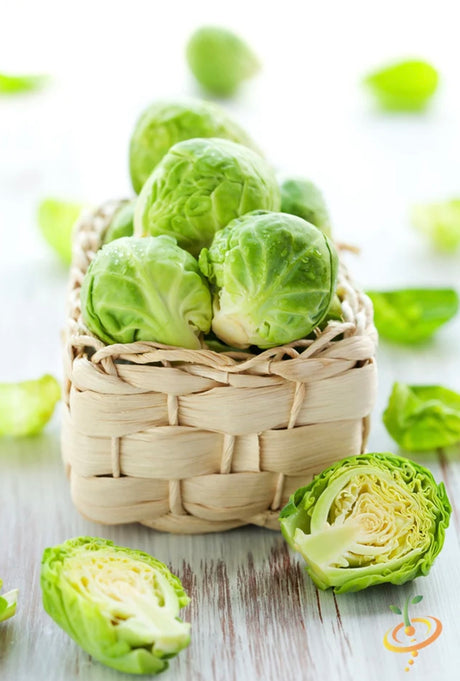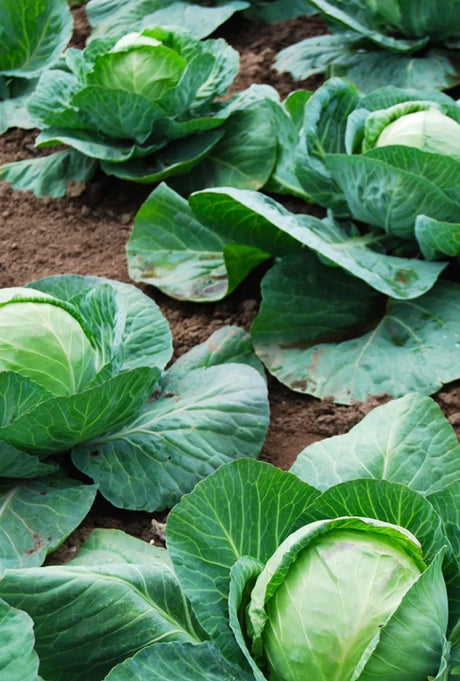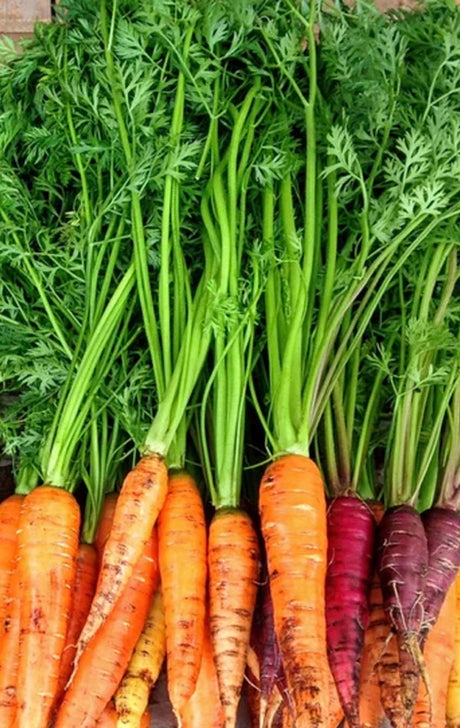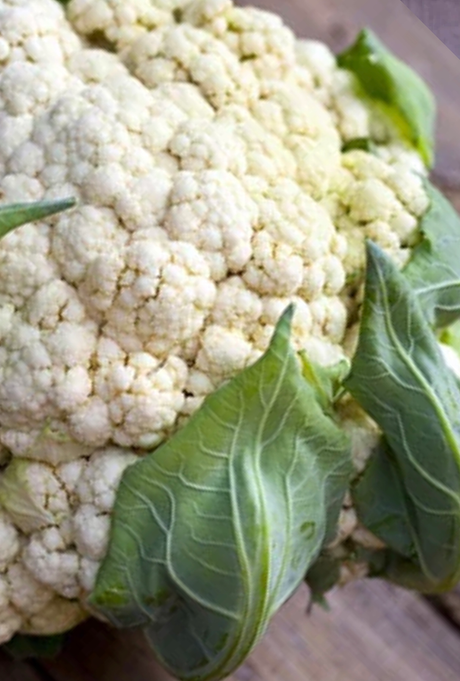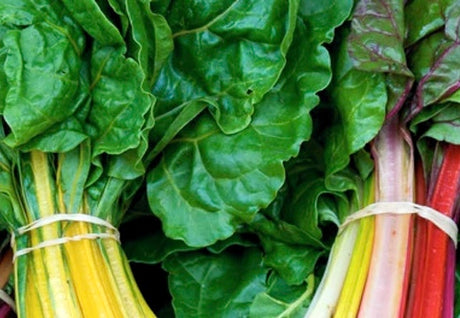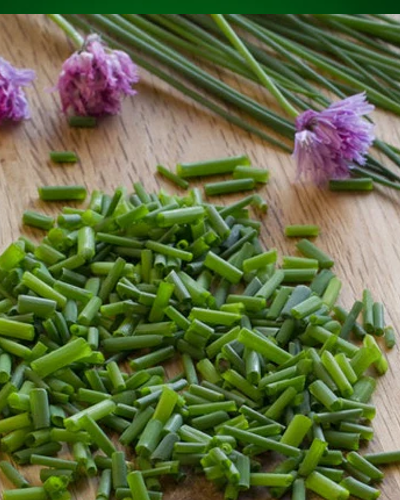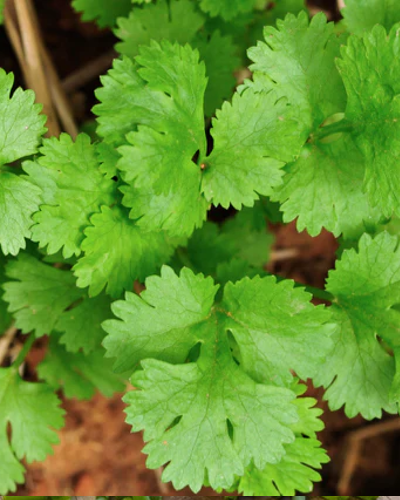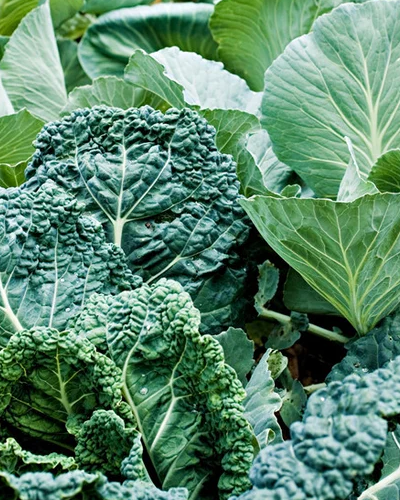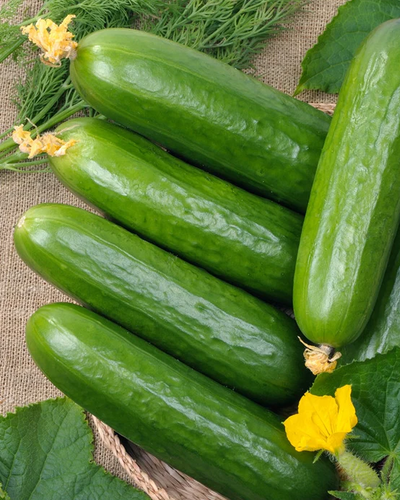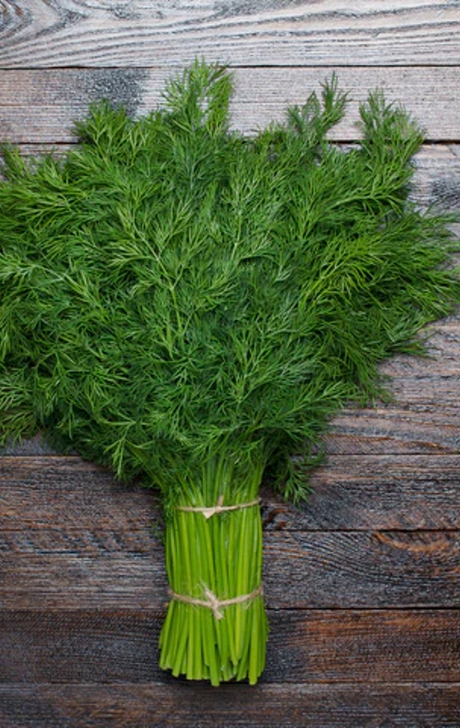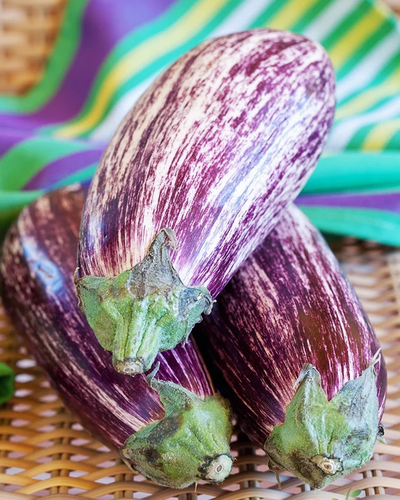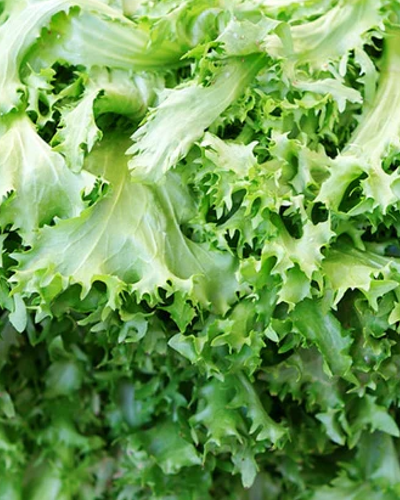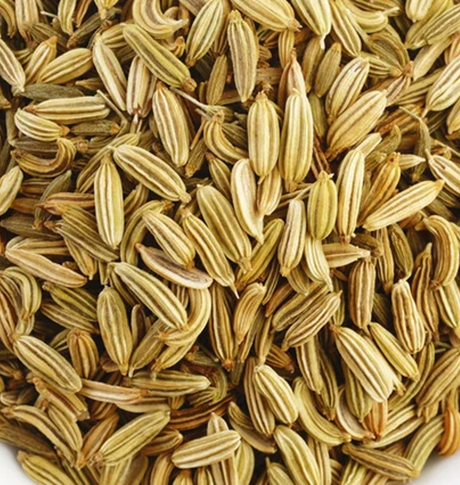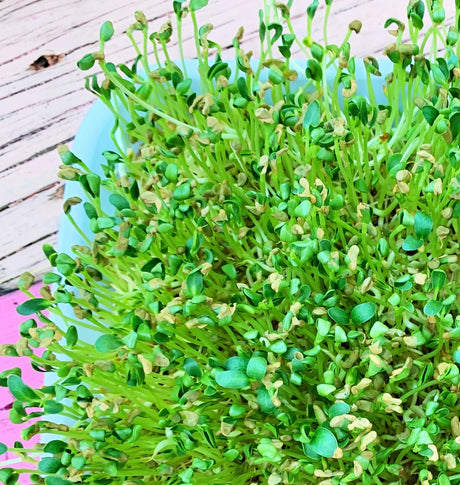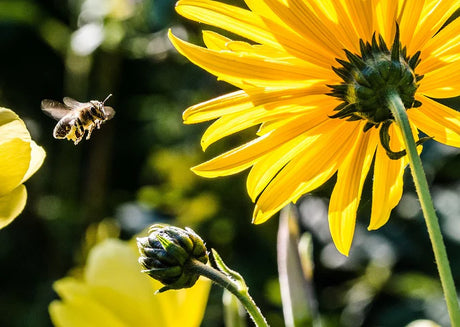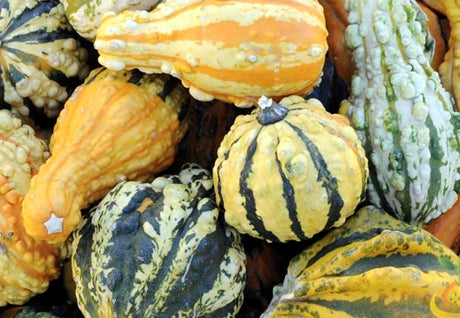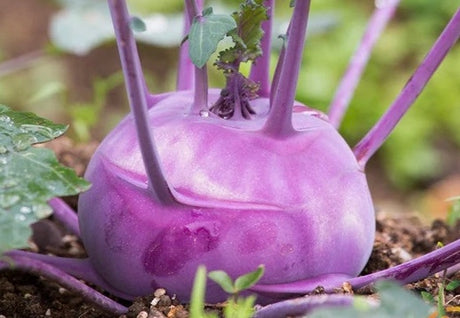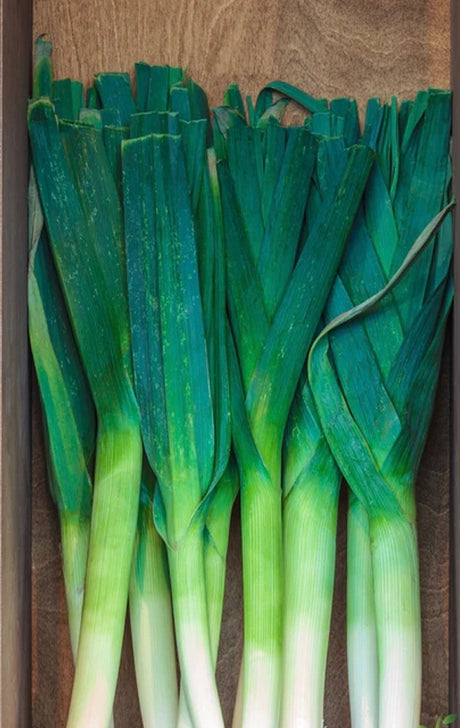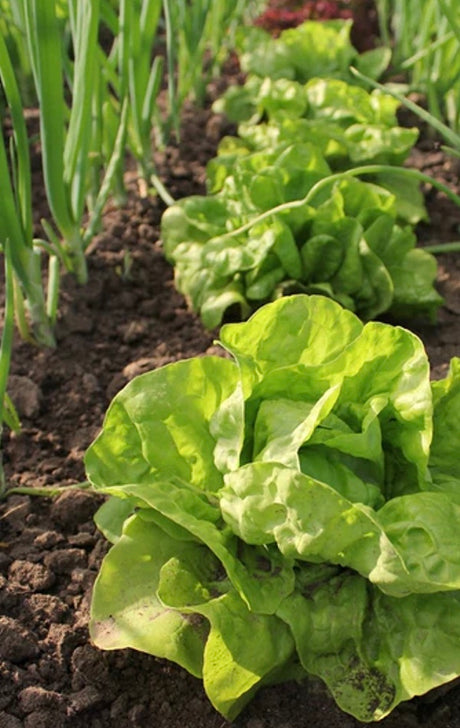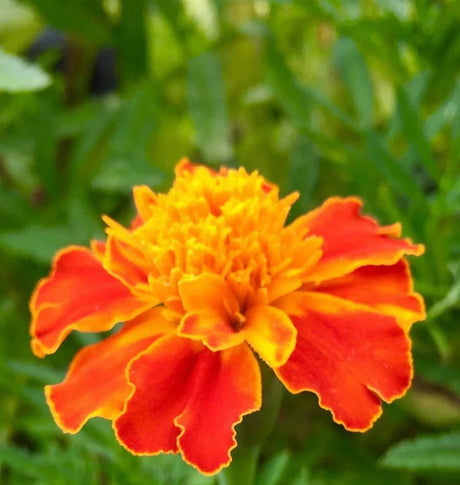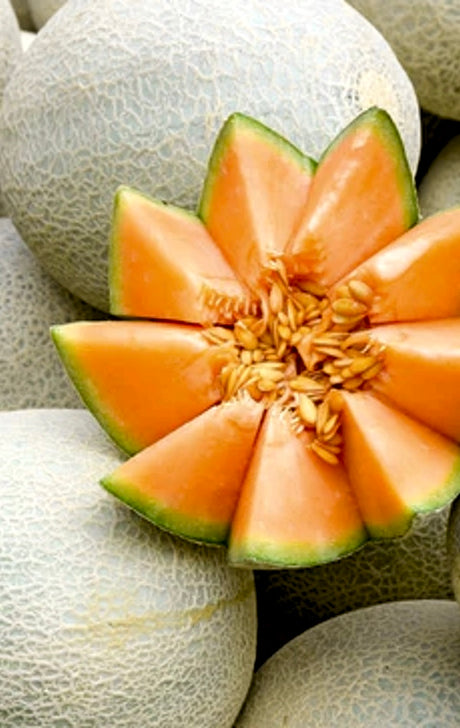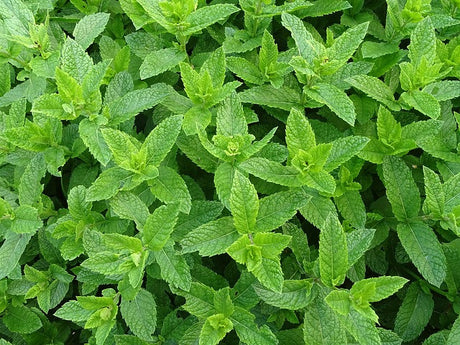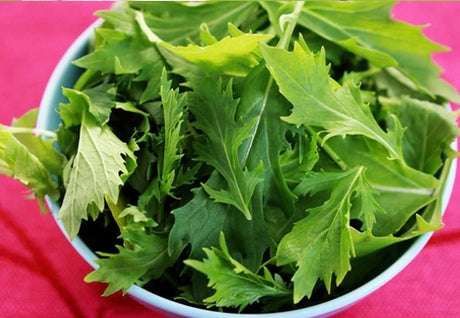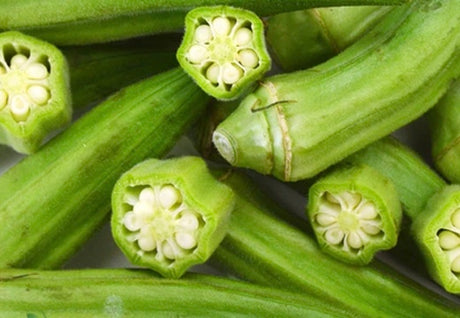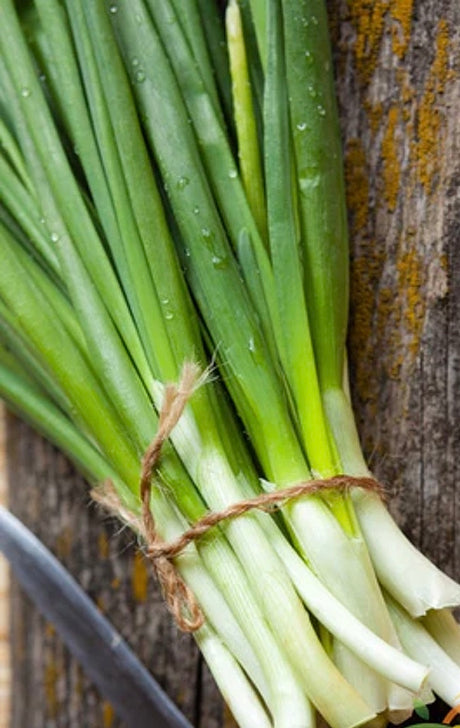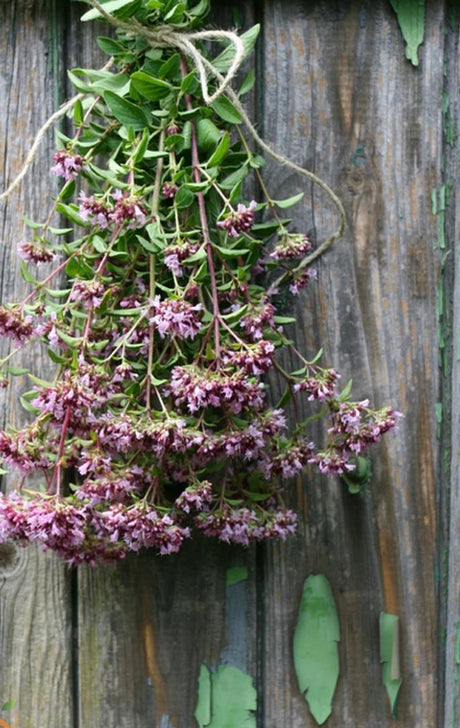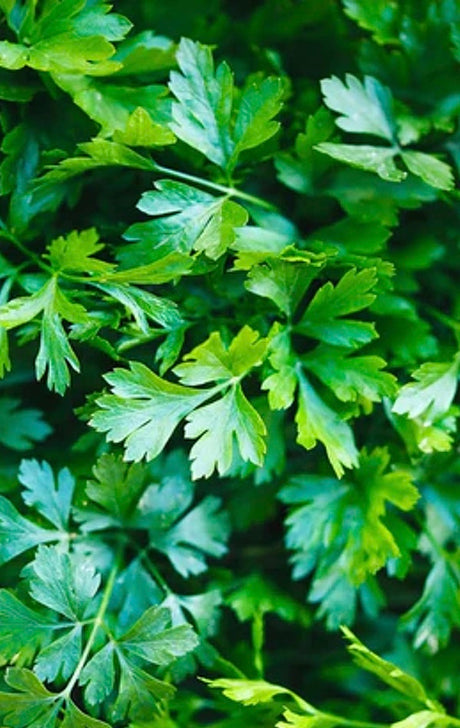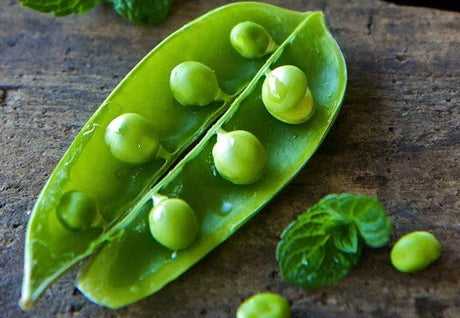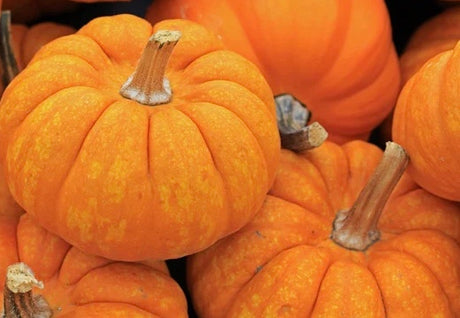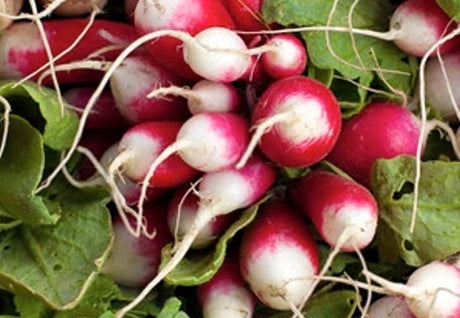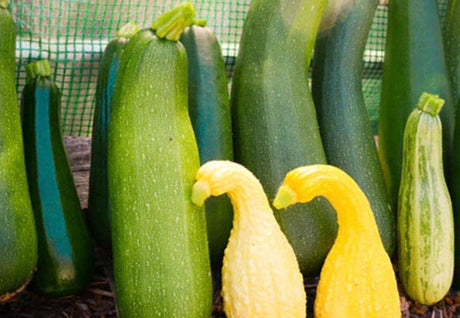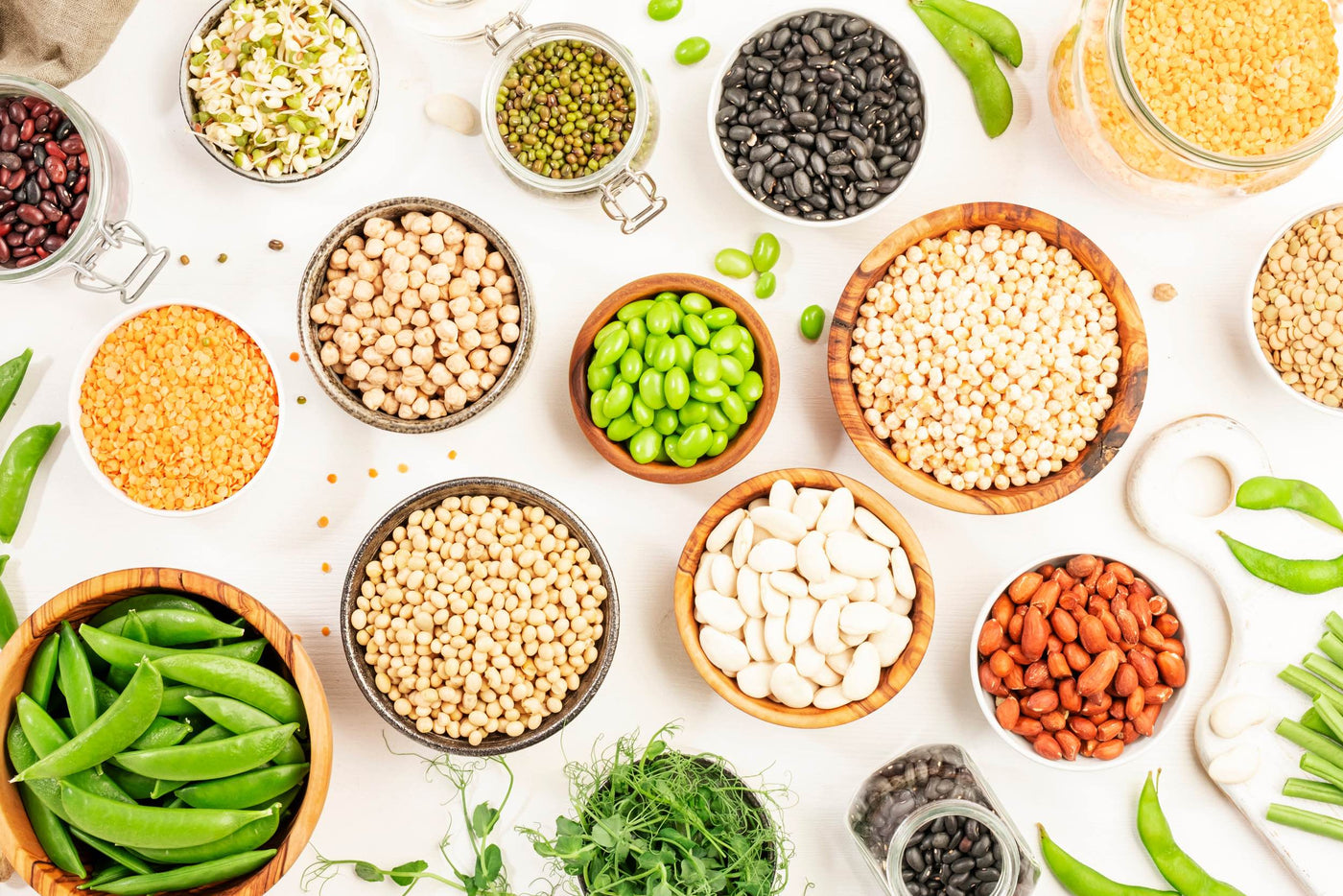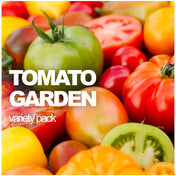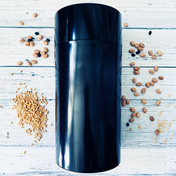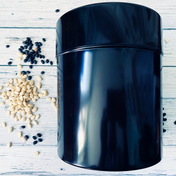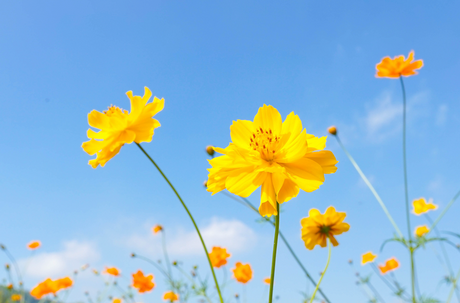Shiso, Red (Perilla Leaf, Japanese Basil)
From $399 USDUnit price /UnavailableDescription
Red Shiso (Perilla frutescens), also called Perilla Leaf and Japanese Basil, is an herb in the mint family with large, deep purple, wrinkled, serrated leaves. Much stronger and spicier than Green Shiso, the crunchy leaves are used mainly in salads, for pickling, and as a natural food coloring. Used extensively in Japanese cuisine, it has a fresh minty-basil flavor with notes of clove and cumin, and a bitter, astringent finish. Pairs well with fish, rice, noodles, and vegetables, especially cucumbers. Also a medicinal herb with antioxidant, anti-bacterial, anti-inflammatory, and antiseptic properties. Its rhizome root can become invasive, so best grown in a container.
- Mint-basil-clove-cumin flavor
- Full sun
- Days to germinate (sprout): 7-21 days
- Days to maturity: 80-85 days
Good companion plants: Arugula, Basil, Bok Choy, Parsley, Tomato
- From $399 USDUnit price /Unavailable
Description
The first thing you should know about the Bird’s Eye Chili Pepper is that it is ... HOT! That’s also the third and fifth things you should know. Small 1"-2", tapered fruit grows on a compact bush and ripens through all the showy colors of a painted bunting, green to purple to orange to red. Pungent with fruity, tropical notes and a serious blast of heat. Use this little Thai chili to add fiery flair to everything from Asian stir fries to Indian curries to South African peri-peri sauce.
- Hot
- Fruity, tropical flavor
- Good for planting in containers & small spaces
- Harvest any color
SEED PLANTING TIPS
- Botanical name: Capsicum annuum
- Pepper length: 1"-2"
- Scoville heat units (SHU): 50,000-100,000/hot
- Plant support: None
- Depth to plant seeds: .25" deep
- Spacing between plants: 12"-18" apart
- Spacing between rows: 18"-24" apart
- Days to germinate (sprout): 7-21 days
- Germination soil temps: 75F-85F
- Soil needs: 6.0-7.0 pH
- Sun needs: Full sun
- Frost hardy: No
- Planting season: Spring, summer
- # of plants per sq. ft.: Appx. 1 plant per sq. ft.
- Days to maturity: 100+ days
Good companion plants: Basil, Carrot, Cucumber, Eggplant, Okra, Rosemary, Sage, Squash, Tomato
-
The Birds Eye pepper is the official wild pepper of Texas. A very hot, often 7x – 8x hotter on the scoville scale than jalapenos!
-
This is a Perennial pepper variety which means that if the soil doesn’t freeze hard in your area, you'll most likely be able to grow these peppers all year round.
-
Easy to grow from seeds.
-
Can be used in place of any hot peppers in many culinary recipes.
-
The commercial hot sauce brand Cholula lists bird peppers as one of its ingredients.
-
Thomas Jefferson first obtained seed of the Bird's Eye Pepper in 1812 from Captain Samuel Brown, who was stationed in San Antonio, Texas. Jefferson recorded planting this pepper in pots and in the kitchen garden in 1814. [source]
All Peppers ⟐ Hot Peppers 📚 Hot Peppers Grow Guide Sprouts/Microgreens - Mustard, Tatsoi
From $399 USDUnit price /UnavailableDescription
Mustard, Sprouts & Micro-Greens
- Mustard is a member of the crucifer family.
- Mustard greens are a popular dish in the Southern U.S. and are an excellent source of vitamins A and C.
- Mustard sprouts have a strong spicy flavor and are usually blended with alfalfa or clover sprouts.
Follow SeedsNow.com's board Mustard on Pinterest. - Mustard is a member of the crucifer family.
- From $399 USDUnit price /Unavailable
Description
The Lavender Vera plant, scientifically known as Lavandula angustifolia, is a perennial herb renowned for its aromatic qualities and vibrant purple flowers. This plant is native to the Mediterranean region and has been cultivated for centuries due to its numerous benefits and applications in gardening, aromatherapy, and culinary arts.
One of the primary advantages of incorporating Lavender Vera into a garden is its ability to attract pollinators. Studies indicate that lavender can attract up to 30% more bees and butterflies compared to other flowering plants. This is particularly beneficial for gardeners aiming to enhance biodiversity and support local ecosystems.
Lavender Vera is also known for its drought-resistant properties. Once established, this plant requires minimal water, making it an excellent choice for sustainable gardening practices. Research shows that lavender can thrive in well-drained soils with low moisture levels, which can reduce the overall water consumption in a garden by approximately 20%.
In addition to its ecological benefits, Lavender Vera has a variety of uses in the home. The essential oils extracted from its flowers are widely used in aromatherapy for their calming effects. According to a study published in the Journal of Alternative and Complementary Medicine, inhaling lavender oil can reduce anxiety levels by up to 30% in individuals experiencing stress.
From a culinary perspective, Lavender Vera can be utilized in various recipes, including desserts, teas, and savory dishes. Its unique flavor profile adds a distinct floral note that can enhance the overall taste of a dish. However, it is essential to use culinary-grade lavender to ensure safety and palatability.
When cultivating Lavender Vera, it is crucial to consider its growing conditions. This plant thrives in full sun and well-drained soil, with a pH level between 6.5 and 7.5. Proper spacing is also vital, as mature plants can reach heights of 2 to 3 feet and spread up to 4 feet wide. Adequate air circulation around the plants can help prevent fungal diseases, which are common in humid environments.
In conclusion, the Lavender Vera plant is a valuable addition to any garden. Its ability to attract pollinators, drought-resistant nature, and versatile applications make it an ideal choice for both novice and experienced gardeners. By understanding the specific needs and benefits of Lavender Vera, gardeners can create a thriving and sustainable environment that enhances both aesthetics and functionality.
Follow SeedsNow.com's board Lavendar on Pinterest. - From $299 USDUnit price /Unavailable
Description
The Black Tuscany Kale, is a unique variety of kale that has gained popularity among gardeners and chefs alike due to its distinctive appearance and robust flavor. This leafy green is characterized by its dark green, crinkled leaves that resemble the skin of a dinosaur, hence its nickname. The plant is not only visually appealing but also offers numerous health benefits, making it an excellent addition to any garden.
Originating from Italy, the Black Tuscany Kale thrives in cooler climates and is known for its resilience. It can withstand frost, which often enhances its flavor, making it a preferred choice for fall and winter gardens. The plant typically reaches a height of 2 to 3 feet and can spread up to 2 feet wide, providing ample foliage for harvesting.
In terms of nutritional value, Black Tuscany Kale is a powerhouse. It is rich in vitamins A, C, and K, as well as minerals such as calcium and iron. Studies have shown that kale is one of the most nutrient-dense foods available, with a high concentration of antioxidants that can help combat oxidative stress in the body. Incorporating this leafy green into your diet can contribute to overall health and wellness.
When cultivating Black Tuscany Kale, it is essential to consider its growing conditions. The plant prefers well-drained, fertile soil with a pH level between 6.0 and 7.5. It thrives in full sun but can tolerate partial shade, making it versatile for various garden layouts. Regular watering is crucial, especially during dry spells, as consistent moisture promotes healthy growth. Additionally, applying organic mulch can help retain soil moisture and suppress weeds.
Harvesting Black Tuscany Kale is straightforward. The leaves can be picked individually or cut from the base of the plant. It is advisable to harvest the outer leaves first, allowing the inner leaves to continue growing. This method not only prolongs the plant's productivity but also ensures a continuous supply of fresh greens throughout the growing season.
In conclusion, the Black Tuscany Kale plant is an excellent choice for gardeners seeking a nutritious and visually striking addition to their vegetable patch. Its hardiness, nutritional benefits, and culinary versatility make it a valuable crop for both home gardeners and professional chefs. By understanding its growing requirements and harvesting techniques, you can successfully cultivate this remarkable plant and enjoy its many benefits in your kitchen.
Click here for complete Kale grow guideFollow SeedsNow.com's board Kale on Pinterest. - From $299 USDUnit price /Unavailable
Description
The Sorrel Large Leaf herb, scientifically known as Rumex acetosa, is a perennial plant that is valued for its distinctive tart flavor and culinary versatility. This herb is characterized by its large, arrow-shaped leaves that can grow up to 12 inches long, making it a prominent addition to any garden. Sorrel is particularly rich in vitamins A and C, and it contains oxalic acid, which contributes to its tangy taste.
In terms of cultivation, Sorrel thrives in well-drained, fertile soil with a pH level ranging from 6.0 to 7.0. It prefers full sun to partial shade, and while it is relatively hardy, it benefits from consistent moisture. The plant can tolerate a range of temperatures, but optimal growth occurs in cooler climates, typically between 60°F and 75°F (15°C to 24°C). Sorrel can be sown directly into the garden in early spring or late summer, and it is known to self-seed, allowing it to return year after year.
Harvesting Sorrel is straightforward; the leaves can be picked as needed, starting from the outer leaves and allowing the inner leaves to continue growing. It is advisable to harvest before the plant flowers, as the leaves can become tougher and more bitter after flowering. The leaves can be used fresh in salads, soups, and sauces, or they can be cooked similarly to spinach. Nutritionally, Sorrel is low in calories, with approximately 22 calories per 100 grams, making it an excellent addition to a healthy diet.
In addition to its culinary uses, Sorrel has been utilized in traditional medicine for its potential health benefits. It is believed to have anti-inflammatory properties and may aid in digestion. However, due to its oxalic acid content, it is recommended that individuals with certain health conditions, such as kidney stones, consult a healthcare professional before consuming large quantities of Sorrel.
In summary, the Sorrel Large Leaf herb plant is a valuable asset to any garden, offering both culinary and potential health benefits. Its ease of cultivation and unique flavor profile make it a popular choice among gardeners and chefs alike. By incorporating Sorrel into your gardening practices, you can enjoy a sustainable source of fresh herbs that enhance your culinary creations.
- From $299 USDUnit price /Unavailable
Description
The Bean Taylor Dwarf plant, scientifically known as Phaseolus vulgaris, is a popular choice among gardeners due to its compact size and high yield. This variety is particularly well-suited for small gardens or container gardening, making it accessible for urban gardeners and those with limited space.
One of the defining characteristics of the Bean Taylor Dwarf is its growth habit. Typically, this plant reaches a height of approximately 18 to 24 inches, which allows for easy harvesting without the need for extensive bending or stretching. The dwarf nature of this plant also means that it can be planted closer together than taller varieties, maximizing space efficiency in the garden.
In terms of productivity, the Bean Taylor Dwarf is known for its prolific output. Under optimal growing conditions, a single plant can produce an impressive yield of beans, often exceeding 1 pound per plant. This makes it an excellent choice for home gardeners looking to supplement their vegetable intake with fresh produce.
The growing requirements for the Bean Taylor Dwarf are relatively straightforward. It thrives in well-drained soil with a pH level between 6.0 and 7.0. Full sun exposure is essential, as this plant requires at least 6 to 8 hours of sunlight daily to achieve optimal growth. Additionally, regular watering is crucial, particularly during dry spells, as beans are sensitive to drought conditions.
From a nutritional standpoint, beans are an excellent source of protein, fiber, and essential vitamins and minerals. The Bean Taylor Dwarf, like other bean varieties, contributes significantly to a balanced diet. It is particularly rich in folate, iron, and magnesium, making it a valuable addition to any meal plan.
When considering pest management, the Bean Taylor Dwarf may be susceptible to common garden pests such as aphids and spider mites. Implementing integrated pest management strategies, including the use of beneficial insects and organic pesticides, can help mitigate these issues while promoting a healthy garden ecosystem.
In conclusion, the Bean Taylor Dwarf plant is a versatile and productive option for gardeners seeking to grow their own food. Its compact size, high yield, and nutritional benefits make it an excellent choice for both novice and experienced gardeners alike. By understanding its growing requirements and potential challenges, gardeners can successfully cultivate this plant and enjoy the fruits of their labor.
Click here to view our full Bean grow guide
Good companion plants: Cucumber, Pea, Rosemary, Thyme, Tomato
-
View your rewards ✨
Earn & redeem BeetCOINS™ 💰 for seriously special rewards!
Learn more about how our rewards program works
Lettuce - Bronze Mignonette (Butterhead)
From $399 USDUnit price /UnavailableDescription
The Bronze Mignonette lettuce (Lactuca sativa) is a distinctive variety of lettuce known for its unique coloration and flavor profile. This heirloom variety features leaves that are a rich bronze color, which not only adds visual interest to the garden but also provides a slightly nutty taste that is favored in gourmet salads. The leaves are tender and crisp, making them an excellent choice for fresh consumption.
In terms of growth characteristics, the Bronze Mignonette lettuce is a loose-leaf variety that typically reaches maturity in approximately 50 to 60 days after sowing. It thrives in cool weather, making it ideal for spring and fall planting. Optimal growing conditions include well-drained, fertile soil with a pH level between 6.0 and 7.0. This lettuce variety prefers full sun but can tolerate partial shade, particularly in warmer climates.
When planting Bronze Mignonette lettuce, it is recommended to space seeds approximately 12 inches apart to allow for adequate air circulation and growth. Regular watering is essential, particularly during dry spells, as consistent moisture helps to maintain the crispness of the leaves. However, care should be taken to avoid waterlogging, which can lead to root rot.
In terms of nutritional value, lettuce is low in calories and provides a good source of vitamins A and K, as well as folate. The Bronze Mignonette variety, in particular, is noted for its high antioxidant content, which contributes to overall health benefits. Incorporating this lettuce into your diet can enhance your intake of essential nutrients while adding a flavorful component to meals.
Harvesting Bronze Mignonette lettuce can begin when the leaves are large enough to eat, typically around 30 days after sowing. It is advisable to harvest the outer leaves first, allowing the inner leaves to continue growing. This method not only prolongs the harvest period but also ensures that the plant remains healthy and productive.
In conclusion, the Bronze Mignonette lettuce is an excellent addition to any garden, offering both aesthetic appeal and culinary versatility. Its unique flavor and nutritional benefits make it a valuable crop for home gardeners and culinary enthusiasts alike. By understanding its growth requirements and harvesting techniques, gardeners can successfully cultivate this delightful variety and enjoy its fresh taste throughout the growing season.
Lettuce - Kagraner Sommer (Butterhead)
From $299 USDUnit price /UnavailableDescription
The Kagraner Sommer lettuce, also known as Summer Lettuce, is a popular variety among gardeners due to its adaptability and ease of cultivation. This lettuce type is characterized by its crisp texture and mild flavor, making it an excellent choice for salads and garnishes. The plant typically reaches a height of 12 to 18 inches and produces large, loose heads that can weigh up to 1 pound each.
One of the key advantages of the Kagraner Sommer lettuce is its resistance to bolting, which is a common issue in many lettuce varieties during warmer months. This trait allows gardeners to extend their growing season, as the plant can thrive in temperatures ranging from 60°F to 75°F (15°C to 24°C). In fact, studies have shown that this variety can maintain optimal growth even when daytime temperatures exceed 80°F (27°C), making it suitable for summer gardening.
When planting Kagraner Sommer lettuce, it is essential to choose a location that receives full sun for at least six hours a day. The soil should be well-draining and rich in organic matter, with a pH level between 6.0 and 7.0. To enhance growth, it is advisable to incorporate compost or well-rotted manure into the soil prior to planting. This practice not only improves soil fertility but also promotes healthy root development.
In terms of spacing, seedlings should be planted approximately 12 inches apart to allow for adequate air circulation and growth. Regular watering is crucial, especially during dry spells, as lettuce has a high water content and requires consistent moisture to prevent wilting. It is recommended to water the plants deeply once or twice a week, depending on weather conditions.
Harvesting Kagraner Sommer lettuce can begin approximately 60 to 70 days after sowing. The leaves can be picked individually or the entire head can be harvested at once. It is important to harvest in the morning when temperatures are cooler, as this helps to preserve the crispness and flavor of the leaves. Once harvested, the lettuce should be stored in a cool, dark place and consumed within a week for optimal freshness.
In conclusion, the Kagraner Sommer lettuce is an excellent addition to any garden, particularly for those looking to grow a reliable and flavorful summer crop. With proper care and attention to growing conditions, gardeners can enjoy a bountiful harvest of this nutritious leafy green.
Tomato - Marglobe Improved (Indeterminate)
From $299 USDUnit price /UnavailableDescription
The Marglobe Improved tomato plant is a hybrid variety that has gained recognition among gardeners for its robust growth and high yield potential. This cultivar is particularly well-suited for home gardens, as it offers a combination of disease resistance and adaptability to various growing conditions. The Marglobe tomato is known for its round, medium-sized fruit, which typically weighs between 5 to 7 ounces and features a rich, red color when fully ripe.
One of the key advantages of the Marglobe Improved tomato plant is its resistance to common tomato diseases, such as Fusarium wilt and Verticillium wilt. Studies have shown that this variety can exhibit up to a 30% higher resistance to these diseases compared to non-hybrid varieties. This characteristic makes it an excellent choice for gardeners looking to minimize crop loss due to disease.
In terms of growth habits, the Marglobe Improved tomato plant is classified as an indeterminate variety, meaning it continues to grow and produce fruit throughout the growing season until frost. This trait allows for extended harvesting periods, often yielding fruit from mid-summer until the first frost in the fall. Gardeners can expect to harvest approximately 10 to 15 pounds of tomatoes per plant, depending on growing conditions and care.
When planting Marglobe tomatoes, it is essential to consider their sunlight and soil requirements. These plants thrive in full sun, requiring at least 6 to 8 hours of direct sunlight daily. Additionally, well-draining soil enriched with organic matter is crucial for optimal growth. Soil pH should be maintained between 6.0 and 6.8 for best results. Regular watering is also important, as tomatoes require consistent moisture to develop properly, with an ideal range of 1 to 2 inches of water per week.
To support the growth of Marglobe Improved tomato plants, gardeners may consider staking or caging the plants to prevent sprawling and to promote better air circulation. This practice can help reduce the risk of fungal diseases and improve overall fruit quality. Fertilization should be approached with care; a balanced fertilizer applied at planting and again during the growing season can enhance growth without leading to excessive foliage at the expense of fruit production.
In conclusion, the Marglobe Improved tomato plant is a valuable addition to any garden, offering a combination of disease resistance, high yield, and adaptability. By understanding its specific needs and growth habits, gardeners can successfully cultivate this variety and enjoy a bountiful harvest of flavorful tomatoes.
SEED PLANTING TIPS
- Botanical name: Solanum lycopersicum
- Growth type: Indeterminate, trellis support, regular pruning
- Tomato size: Medium
- Depth to plant seeds: .25" deep
- Spacing between plants: 24" apart
- Spacing between rows: 36"-48" apart
- Days to germinate (sprout): 7-14 days
- Germination soil temps: 75F-95F
- Soil needs: 6.0-6.5 pH
- Sun needs: Full sun
- Frost hardy: No
- Planting season: Spring, summer
- # of plants per sq. ft.: Appx. 1 plant per 2 sq. ft.
- Days to maturity: 70-80 days
Click here to view our full Tomato grow guide
Good companion plants: Basil, Borage, Onion, Parsley, Pepper
Pepper (Hot) - Pasillo Beijio 🇲🇽 (Pasilla de Oaxaca) 🔥
From $499 USDUnit price /UnavailableDescription
The Pasillo Beijio pepper, also known as the Pasilla de Oaxaca, is a unique variety of chili pepper that is highly regarded for its rich flavor profile and versatility in culinary applications. This pepper is native to Mexico 🇲🇽 and is often used in traditional dishes, making it a valuable addition to any garden focused on organic produce.
Characterized by its dark green to brownish color, the Pasillo Beijio pepper typically measures between 6 to 8 inches in length. When dried, it transforms into a deep, wrinkled pod that is commonly used in sauces, salsas, and as a seasoning for various dishes. The flavor of the Pasillo Beijio is often described as smoky and earthy, with a moderate heat level that ranges from 1,000 to 2,500 Scoville Heat Units (SHU). This makes it suitable for those who enjoy a mild to medium heat in their culinary creations.
In terms of cultivation, the Pasillo Beijio pepper plant thrives in warm climates and requires full sun exposure for optimal growth. It is advisable to plant these peppers in well-drained soil enriched with organic matter to promote healthy development. The plant typically reaches a height of 2 to 3 feet and can produce a substantial yield, making it an excellent choice for home gardeners looking to grow their own peppers.
When growing Pasillo Beijio peppers, it is essential to monitor the watering schedule carefully. These plants prefer consistent moisture but should not be overwatered, as this can lead to root rot. Fertilization with a balanced organic fertilizer can also enhance growth and fruit production. Harvesting should occur when the peppers are fully mature, which is indicated by their dark color and firm texture.
In addition to their culinary uses, Pasillo Beijio peppers are also rich in vitamins A and C, as well as antioxidants, contributing to their health benefits. Incorporating these peppers into your diet can support immune function and overall health.
In summary, the Pasillo Beijio pepper plant is an excellent choice for gardeners interested in growing flavorful and versatile peppers. With proper care and attention, this plant can yield a bountiful harvest that enhances both the garden and the kitchen.
SEED PLANTING TIPS
- Botanical name: Capsicum annuum
- Plant support: Tomato cage or stake
- Depth to plant seeds: .25" deep
- Spacing between plants: 18"-24" apart
- Spacing between rows: 24"-36" apart
- Days to germinate (sprout): 7-21 days
- Germination soil temps: 75F-85F
- Soil needs: 6.0-7.0 pH
- Sun needs: Full sun
- Frost hardy: No
- Planting season: Spring, summer
- # of plants per sq. ft.: Appx. 1 plant per sq. ft.
- Days to maturity: 75-85 days
Good companion plants: Basil, Carrot, Cucumber, Eggplant, Okra, Rosemary, Sage, Squash, TomatoAll Peppers ⟐ Hot Peppers 📚 Hot Peppers Grow Guide Pepper (Hot) - Mushroom, Yellow 🔥
From $299 USDUnit price /UnavailableDescription
The Hot Mushroom Pepper, scientifically known as Capsicum annuum, is a unique variety of chili pepper that is gaining popularity among gardeners and culinary enthusiasts alike. This pepper is characterized by its distinctive mushroom-like shape and vibrant color, which can range from green to red as it ripens. The plant typically reaches a height of 18 to 24 inches and produces fruit that can measure approximately 2 to 3 inches in length.
One of the notable features of the Hot Mushroom Pepper is its heat level, which is measured on the Scoville scale. This pepper generally falls within the range of 1,000 to 5,000 Scoville Heat Units (SHU), making it a moderately spicy option for those who enjoy a bit of heat in their dishes. For comparison, jalapeño peppers typically range from 2,500 to 8,000 SHU, indicating that the Hot Mushroom Pepper can provide a milder kick.
In terms of cultivation, the Hot Mushroom Pepper thrives in warm climates and requires full sun exposure for optimal growth. It is essential to plant these peppers in well-draining soil enriched with organic matter to ensure healthy development. The ideal soil pH for growing Hot Mushroom Peppers is between 6.0 and 6.8. Regular watering is crucial, especially during dry spells, as the plant prefers consistent moisture without becoming waterlogged.
Harvesting the Hot Mushroom Pepper typically occurs around 70 to 80 days after planting, once the fruit has reached its full size and color. It is advisable to use pruning shears or scissors to cut the peppers from the plant to avoid damaging the stems. The harvested peppers can be used fresh in salads, salsas, or cooked dishes, and they can also be dried or pickled for preservation.
In addition to their culinary uses, Hot Mushroom Peppers are also known for their health benefits. They are rich in vitamins A and C, as well as antioxidants, which can contribute to overall health and well-being. The capsaicin found in peppers has been studied for its potential anti-inflammatory properties and its ability to boost metabolism.
In summary, the Hot Mushroom Pepper plant is an excellent addition to any garden, offering both aesthetic appeal and culinary versatility. With proper care and attention, gardeners can enjoy a bountiful harvest of these unique peppers, enhancing their meals while reaping the health benefits associated with their consumption.
SEED PLANTING TIPS
- Botanical name: Capsicum annuum
- Plant support: Tomato cage or stake
- Depth to plant seeds: .25" deep
- Spacing between plants: 18"-24" apart
- Spacing between rows: 24"-36" apart
- Days to germinate (sprout): 7-21 days
- Germination soil temps: 75F-85F
- Soil needs: 6.0-7.0 pH
- Sun needs: Full sun
- Frost hardy: No
- Planting season: Spring, summer
- # of plants per sq. ft.: Appx. 1 plant per sq. ft.
- Days to maturity: 75-85 days
Good companion plants: Basil, Carrot, Cucumber, Eggplant, Okra, Rosemary, Sage, Squash, TomatoAll Peppers ⟐ Hot Peppers 📚 Hot Peppers Grow Guide Pepper (Hot) - Mushroom, Red 🔥
From $399 USDUnit price /UnavailableDescription
The Hot Mushroom Pepper, scientifically known as Capsicum annuum, is a unique variety of chili pepper that is gaining popularity among gardeners and culinary enthusiasts alike. This pepper is characterized by its distinctive mushroom-like shape and vibrant color, which can range from green to red as it ripens. The plant typically reaches a height of 18 to 24 inches and produces fruit that can measure approximately 2 to 3 inches in length.
One of the notable features of the Hot Mushroom Pepper is its heat level, which is measured on the Scoville scale. This pepper generally falls within the range of 1,000 to 5,000 Scoville Heat Units (SHU), making it a moderately spicy option for those who enjoy a bit of heat in their dishes. For comparison, jalapeño peppers typically range from 2,500 to 8,000 SHU, indicating that the Hot Mushroom Pepper can provide a milder kick.
In terms of cultivation, the Hot Mushroom Pepper thrives in warm climates and requires full sun exposure for optimal growth. It is essential to plant these peppers in well-draining soil enriched with organic matter to ensure healthy development. The ideal soil pH for growing Hot Mushroom Peppers is between 6.0 and 6.8. Regular watering is crucial, especially during dry spells, as the plant prefers consistent moisture without becoming waterlogged.
Harvesting the Hot Mushroom Pepper typically occurs around 70 to 80 days after planting, once the fruit has reached its full size and color. It is advisable to use pruning shears or scissors to cut the peppers from the plant to avoid damaging the stems. The harvested peppers can be used fresh in salads, salsas, or cooked dishes, and they can also be dried or pickled for preservation.
In addition to their culinary uses, Hot Mushroom Peppers are also known for their health benefits. They are rich in vitamins A and C, as well as antioxidants, which can contribute to overall health and well-being. The capsaicin found in peppers has been studied for its potential anti-inflammatory properties and its ability to boost metabolism.
In summary, the Hot Mushroom Pepper plant is an excellent addition to any garden, offering both aesthetic appeal and culinary versatility. With proper care and attention, gardeners can enjoy a bountiful harvest of these unique peppers, enhancing their meals while reaping the health benefits associated with their consumption.
SEED PLANTING TIPS
- Botanical name: Capsicum annuum
- Plant support: Tomato cage or stake
- Depth to plant seeds: .25" deep
- Spacing between plants: 18"-24" apart
- Spacing between rows: 24"-36" apart
- Days to germinate (sprout): 7-21 days
- Germination soil temps: 75F-85F
- Soil needs: 6.0-7.0 pH
- Sun needs: Full sun
- Frost hardy: No
- Planting season: Spring, summer
- # of plants per sq. ft.: Appx. 1 plant per sq. ft.
- Days to maturity: 75-85 days
Good companion plants: Basil, Carrot, Cucumber, Eggplant, Okra, Rosemary, Sage, Squash, TomatoAll Peppers ⟐ Hot Peppers 📚 Hot Peppers Grow Guide - From $399 USDUnit price /Unavailable
Description
Are you looking to add a new pepper plant to your garden? Consider the Marconi pepper plant, a popular choice among gardeners for its mild flavor and versatility in the kitchen. Let's explore the ins and outs of growing this plant in your own backyard.
What are Marconi peppers?
Marconi peppers, also known as Italian frying peppers, are elongated, sweet peppers that are typically harvested when they are green or red. These peppers are prized for their thin walls, making them perfect for sautéing, grilling, or roasting. With a mild, slightly sweet flavor, Marconi peppers are a favorite in Mediterranean cuisine.
How to grow Marconi pepper plants
When planting Marconi pepper seeds, it's important to choose a sunny spot in your garden with well-draining soil. These plants thrive in warm weather, so make sure to plant them after the last frost date in your area. Space the plants about 18 inches apart to allow for proper growth.
Water the plants regularly, ensuring that the soil remains consistently moist but not waterlogged. Fertilize the plants every few weeks with a balanced fertilizer to promote healthy growth. As the peppers begin to develop, provide support for the plants to prevent them from bending or breaking under the weight of the fruit.
Harvesting and using Marconi peppers
Marconi peppers can be harvested when they reach their full size, typically around 6-8 inches in length. You can pick the peppers when they are green for a milder flavor or wait until they turn red for a sweeter taste. Simply cut the peppers from the plant using a pair of scissors or pruning shears.
These versatile peppers can be used in a variety of dishes, from stir-fries and salads to sandwiches and pasta dishes. Roast them for a smoky flavor, or pickle them to enjoy their crisp texture year-round. The possibilities are endless with Marconi peppers in your kitchen!
Are you ready to add the Marconi pepper plant to your garden? With the right care and attention, you can enjoy a bountiful harvest of these delicious peppers throughout the growing season. Happy gardening!
SEED PLANTING TIPS
- Botanical name: Capsicum annuum
- Plant support: Tomato cage or stake
- Depth to plant seeds: .25" deep
- Spacing between plants: 18"-24" apart
- Spacing between rows: 24"-36" apart
- Days to germinate (sprout): 7-21 days
- Germination soil temps: 75F-85F
- Soil needs: 6.0-7.0 pH
- Sun needs: Full sun
- Frost hardy: No
- Planting season: Spring, summer
- # of plants per sq. ft.: Appx. 1 plant per 2 sq. ft.
- Days to maturity: 65-80 days
Good companion plants: Basil, Carrot, Cucumber, Eggplant, Okra, Rosemary, Sage, Squash, Tomato
All Peppers ⟐ Sweet Peppers 📚 Sweet Peppers Grow Guide Pepper (Sweet) - Marconi, Golden
From $399 USDUnit price /UnavailableDescription
Are you looking to add a new pepper plant to your garden? Consider the Marconi pepper plant, a popular choice among gardeners for its mild flavor and versatility in the kitchen. Let's explore the ins and outs of growing this plant in your own backyard.
What are Marconi peppers?
Marconi peppers, also known as Italian frying peppers, are elongated, sweet peppers that are typically harvested when they are green or red. These peppers are prized for their thin walls, making them perfect for sautéing, grilling, or roasting. With a mild, slightly sweet flavor, Marconi peppers are a favorite in Mediterranean cuisine.
How to grow Marconi pepper plants
When planting Marconi pepper seeds, it's important to choose a sunny spot in your garden with well-draining soil. These plants thrive in warm weather, so make sure to plant them after the last frost date in your area. Space the plants about 18 inches apart to allow for proper growth.
Water the plants regularly, ensuring that the soil remains consistently moist but not waterlogged. Fertilize the plants every few weeks with a balanced fertilizer to promote healthy growth. As the peppers begin to develop, provide support for the plants to prevent them from bending or breaking under the weight of the fruit.
Harvesting and using Marconi peppers
Marconi peppers can be harvested when they reach their full size, typically around 6-8 inches in length. You can pick the peppers when they are green for a milder flavor or wait until they turn red for a sweeter taste. Simply cut the peppers from the plant using a pair of scissors or pruning shears.
These versatile peppers can be used in a variety of dishes, from stir-fries and salads to sandwiches and pasta dishes. Roast them for a smoky flavor, or pickle them to enjoy their crisp texture year-round. The possibilities are endless with Marconi peppers in your kitchen!
Are you ready to add the Marconi pepper plant to your garden? With the right care and attention, you can enjoy a bountiful harvest of these delicious peppers throughout the growing season. Happy gardening!
SEED PLANTING TIPS
- Botanical name: Capsicum annuum
- Plant support: Tomato cage or stake
- Depth to plant seeds: .25" deep
- Spacing between plants: 18"-24" apart
- Spacing between rows: 24"-36" apart
- Days to germinate (sprout): 7-21 days
- Germination soil temps: 75F-85F
- Soil needs: 6.0-7.0 pH
- Sun needs: Full sun
- Frost hardy: No
- Planting season: Spring, summer
- # of plants per sq. ft.: Appx. 1 plant per 2 sq. ft.
- Days to maturity: 65-80 days
Good companion plants: Basil, Carrot, Cucumber, Eggplant, Okra, Rosemary, Sage, Squash, Tomato
All Peppers ⟐ Sweet Peppers 📚 Sweet Peppers Grow Guide Amaranth - Tri Color (Joseph's Coat) seeds
From $399 USDUnit price /UnavailableDescription
Amaranthus tricolor, commonly known as Joseph's Coat, is a vibrant and visually striking flowering plant that is often utilized in ornamental gardening. This species is characterized by its broad, colorful leaves that can display a range of hues including red, yellow, and green. The plant typically reaches a height of 2 to 4 feet and can spread up to 3 feet wide, making it a prominent feature in garden landscapes.
One of the notable aspects of Amaranthus tricolor is its adaptability to various soil types. It thrives in well-drained soils and can tolerate poor soil conditions, which makes it an excellent choice for gardeners looking to enhance their landscapes with minimal maintenance. The plant prefers full sun exposure, requiring at least six hours of direct sunlight each day to achieve optimal growth and color vibrancy.
In terms of cultivation, Amaranthus tricolor is relatively easy to grow from seeds. The seeds should be sown directly into the garden after the last frost date, as the plant is sensitive to cold temperatures. Germination typically occurs within 7 to 14 days under suitable conditions. Once established, the plant is drought-tolerant, requiring watering only during prolonged dry spells.
From a nutritional perspective, Amaranthus tricolor is not only ornamental but also edible. The young leaves can be harvested and consumed in salads or cooked as a green vegetable, providing a source of vitamins A and C, as well as essential minerals. This dual-purpose nature enhances its appeal for gardeners interested in both aesthetics and food production.
Furthermore, Amaranthus tricolor attracts beneficial insects, such as pollinators, which can enhance the overall health of the garden ecosystem. The flowers, which are small and clustered, bloom throughout the summer and into the fall, providing a continuous source of color and attracting various species of bees and butterflies.
In conclusion, Amaranthus tricolor is a versatile and attractive addition to any garden. Its vibrant foliage, ease of cultivation, and nutritional benefits make it a valuable choice for both ornamental and edible gardening. Gardeners should consider incorporating this plant into their landscapes to enjoy its beauty and contributions to biodiversity.
Health Benefits of Amaranth
Do you have grey hair? Amaranth helps to prevent premature graying, mainly due to the minerals it contains. It helps to lower bad cholesterol and also can reduce inflammation and ease pain. Especially important for people suffering from diabetes, heart disease, and stroke. Great for tackling high blood pressure and may even help prevent cancer. Don't forget it is a wonderful source of protein.
Ways to Consume Amaranth
Amaranth is a lot like quinoa as far as being a "protein packed" seed. You can roast, pop, or boil these seeds. Use as a breakfast cereal, or combine it with other grains. Amaranth is a wonderful soup thickener because of it's gelatinous quality when cooked. Cook the leaves of the Amaranth plant, similar to how you would cook/use spinach leaves.

See Amaranth Recipes & Growing Tips on our Pinterest Board
Lettuce - Marvel of Four Seasons
From $399 USDUnit price /UnavailableDescription

Marvel of Four Seasons lettuce plant, also known as Lactuca sativa, is a popular variety of lettuce that is highly sought after by gardeners and salad enthusiasts. This unique lettuce variety is known for its beautiful red and green leaves, making it a visually appealing addition to any garden or salad bowl.
Marvel of Four Seasons lettuce is a cool-season crop that thrives in mild climates and can be grown in both spring and fall. It is a loose-leaf lettuce variety, which means that the leaves grow in a loose, open head rather than forming a tight, compact head like other lettuce varieties.
One of the key features of Marvel of Four Seasons lettuce is its exceptional taste. The leaves have a delicate, buttery flavor with a slight hint of bitterness, making it a versatile ingredient in salads, sandwiches, and wraps. Its crisp texture adds a refreshing crunch to any dish.
Growing Marvel of Four Seasons lettuce is relatively easy, making it a great choice for both beginner and experienced gardeners. It prefers well-drained soil and requires regular watering to keep the soil moist. This lettuce variety can be grown in containers, raised beds, or directly in the ground.
When planting Marvel of Four Seasons lettuce, it is important to sow the seeds thinly and cover them with a thin layer of soil. The seeds should be spaced about 6 inches apart to allow room for the plants to grow. It is recommended to provide the plants with partial shade to protect them from excessive heat.
Harvesting Marvel of Four Seasons lettuce is a rewarding experience. The leaves can be harvested individually as needed or the entire plant can be harvested at once. To harvest the leaves, simply cut them off at the base using a sharp knife or scissors. The plant will continue to produce new leaves, allowing for multiple harvests throughout the growing season.
Marvel of Four Seasons lettuce is not only a delicious and visually appealing addition to your garden, but it is also packed with nutritional benefits. It is a good source of vitamins A and K, as well as folate and fiber. Adding this lettuce variety to your diet can contribute to a healthy and balanced lifestyle.
Whether you are a seasoned gardener or just starting out, Marvel of Four Seasons lettuce is a fantastic choice for your garden. Its beautiful appearance, delicious taste, and nutritional benefits make it a must-have for any lettuce lover. Start growing your own Marvel of Four Seasons lettuce today and enjoy the satisfaction of harvesting your own fresh, homegrown lettuce.
Click here for our complete Lettuce grow guideSprouts/Microgreens - Pea, Brown Speckled
From $399 USDUnit price /UnavailableDescription
- Organic
- Ready to eat as a sprout just a soon as they pop.
- Sweet and delicious in salads and casseroles.
- Day to Maturity | 3-7 days
Follow SeedsNow.com's board Green Pea Sprouts on Pinterest. Shiso, Green (Perilla Leaf, Japanese Basil)
From $399 USDUnit price /UnavailableDescription
Green Shiso (Perilla frutescens), also called Perilla Leaf and Japanese Basil, is an herb in the mint family with large, bright green, wrinkled, serrated leaves. Not as spicy as Red Shiso. Used extensively in Japanese cuisine, it has a fresh minty-basil flavor with notes of clove and cumin, and a bitter, astringent finish. Pairs well with fish, rice, noodles, and vegetables, especially cucumbers. Also a medicinal herb with antioxidant, anti-bacterial, anti-inflammatory, and antiseptic properties. Its rhizome root can become invasive, so best grown in a container.
- Mint-basil-clove-cumin flavor
- Full sun
- Days to germinate (sprout): 7-21 days
- Days to maturity: 80-85 days
Good companion plants: Arugula, Basil, Bok Choy, Parsley, Tomato
Pea - Alaska Early (Earliest of All)
From $399 USDUnit price /UnavailableDescription
The Alaska Early Pea (Pisum sativum), originally named Earliest of All, has a lot of great qualities. As you can guess, it’s one of the earliest to produce in only 55 days. It’s a semi-dwarf frost-tolerant bush variety that grows to only 2'-3' tall and doesn’t require staking. And it produces lots of 2"-3" pods with 5-8 small, plump, smooth, peas inside. Nice flavor that isn’t too sweet. It was renamed in the late 1800s after the steamship Alaska. Can be grown in Alaska, the lower 48, and Hawaii.
- Not too sweet
- Full sun
- High yields
- Early maturity—55 days
- Good for containers
Good companion plants: Bean, Carrot, Cucumber, Parsley, Pepper, Sage, Spinach, Squash, Strawberry, Thyme
SEED PLANTING TIPS
- Botanical name: Pisum sativum
- Hardiness zones: 2-11
- Pea type: English/shelling - remove peas from pod before eating
- Growth habit: Bush - no support
- Depth to plant seeds: 1" deep
- Spacing between plants: 2"-3" apart
- Spacing between rows: 18"-24" apart
- Days to germinate (sprout): 7-21 days
- Germination soil temps: 40F-85F
- Soil needs: Clay, sandy, loamy, chalky, rich, moist, well-drained
- Soil pH: 5.5-7.0
- Sun needs: Full sun
- Frost tolerant: Yes
- # of plants per sq. ft.: Appx. 8 plants per sq. ft.
- Days to maturity: 55-60 days
- From $399 USDUnit price /Unavailable
Description
The Green Arrow Pea (Pisum sativum) is an old English heirloom shelling pea. A semi-dwarf frost-tolerant bush variety that grows to only 2'-3' tall and doesn't require staking. High yields for a compact plant. Produces lots of 4"-5" pods with 9-11 plump, tender, sweet peas inside. Delicious fresh or cooked, if you don’t eat them all before you make it into the house.
- Sweet and tender
- Full sun
- High yields
- Good fresh or cooked
- Good for containers
Good companion plants: Bean, Carrot, Cucumber, Parsley, Pepper, Sage, Spinach, Squash, Strawberry, Thyme
SEED PLANTING TIPS
- Hardiness zones: 2-11
- Planting season: Spring
- Pea type: English/shelling - remove peas from pod before eating
- Growth habit: Bush - no support
- Depth to plant seeds: 1" deep
- Spacing between plants: 2"-3" apart
- Spacing between rows: 18"-24" apart
- Days to germinate (sprout): 7-21 days
- Germination soil temps: 40F-85F
- Soil needs: Clay, sandy, loamy, chalky, rich, moist, well-drained
- Soil pH: 5.5-7.0
- Sun needs: Full sun
- Frost tolerant: Yes
- # of plants per sq. ft.: Appx. 8 plants per sq. ft.
- Days to maturity: 65-70 days
- From $399 USDUnit price /Unavailable
Description
Epazote (Dysphania ambrosioides) is a culinary herb with a lemony green color and serrated leaves, traditionally used to add a bold umami-type depth to Mexican cuisine. Its flavor has been described as a mix of mint and savory with a bit of camphor or turpentine thrown in. An acquired taste. As a companion plant, it attracts beneficial insects and masks the scent of other plants that suffer from pest damage. Also used medicinally to help with stomach upset and to combat intestinal parasites. Can become invasive, so best grown in a container.
- Easy to grow
- Culinary and medicinal uses
- Days to germinate (sprout): 5-7 days
- Quick maturity—only 40 days
Tomato - Thessaloniki (Indeterminate)
From $399 USDUnit price /UnavailableDescription
The Thessaloniki Tomato is a Greek heirloom. A tomato so epic that Homer could have written an ode to its plump round fruits that ripen from golden yellow to vivid red, high yields in high temps, and a rich, earthy flavor that’s well-balanced between sweet and acidic. This one’s a keeper, both in the garden and on the countertop. By the time you eat a few of these, you may even be able to pronounce it.
- Well-balanced flavor
- Heat tolerant
- Early producer
- Stores well
SEED PLANTING INFO
- Botanical name: Solanum lycopersicum
- Growth type: Indeterminate, trellis support, regular pruning
- Tomato size: Medium
- Depth to plant seeds: .25" deep
- Spacing between plants: 24" apart
- Spacing between rows: 36"-48" apart
- Days to germinate (sprout): 7-14 days
- Germination soil temps: 75F-95F
- Soil needs: 6.0-6.5 pH
- Sun needs: Full sun
- Frost hardy: No
- Planting season: Spring, summer
- # of plants per sq. ft.: Appx. 1 plant per 2 sq. ft.
- Days to maturity: 75-80 days
Click here to view our full Tomato grow guide
Good companion plants: Basil, Borage, Onion, Parsley, Pepper
Sweet Woodruff (Sweet-Scented Bedstraw)
From $499 USDUnit price /UnavailableDescription
Sweet Woodruff (Botanical name: Galium odoratum) also called Sweet-Scented Bedstraw, is a fast-growing, mat-forming herb and ground cover with dark green leaves and small, white, waxy, star-shaped flowers that bloom in spring. When crushed or cut, and especially dried, it has a grassy vanilla fragrance. Prefers partial to full shade, even under a Black Walnut tree. Add the leaves to fruit salads, jellies, and herbal teas, and use the flowers as an adorable and edible garnish. Reseeding and shallow runner roots enable it to spread easily.
- Grassy vanilla fragrance
- Culinary and medicinal
- Attracts bees, butterflies, and other pollinators
As a companion plant, it attracts all sorts of friendly pollinators to the garden.
As a medicinal herb, Sweet Woodruff has been used internally to treat congestion, insomnia, migraine headaches, nerve pain, and water retention, and externally to treat burns, wounds, and swelling.
⚠️ Contains naturally occurring coumarin and should not be ingested in large quantities if you are taking medication for circulatory disorders or are pregnant.
⚠️ Medicinal properties are presented as information only, and are not a recommendation or prescription for use. Consult a medical professional before using any herb medicinally.
SEED PLANTING TIPS
- Botanical name: Galium odoratum
- Life cycle: Herbaceous perennial
- Planting season: Spring, fall, winter
- Days to maturity: 90-120 days
- Depth to plant seeds: 1/4" deep
- Days to germinate (sprout): 10-200 days
- Germination soil temps: 60F-70F
- Spacing between plants: 8"-12" apart
- Spacing between rows: 18"-24" apart
- # of plants per sq. ft.: Appx. 1 plant per sq. ft.
- Soil types: Clay, sandy, loamy, rich, moist, well-drained
- Soil pH: 4.3-8.3
- Sun needs: Full shade, part shade
- Water needs: Average
- Cold stratify: Yes
- Frost tolerant: Yes
- Heat tolerant: No
- Drought tolerant: No
- Deer resistant: Yes
- Culinary use: Yes
- Medicinal use: Yes
- From $399 USDUnit price /Unavailable
Description
The Golden Wax Bush Bean is a beautiful buttery treat in the garden. With its long, straight yellow pods, this heavy producing stringless bean is easy to cook or can. Grow these alongside Borlotti Bush Beans and Royal Burgundy Bush Beans for an artistic change from the usual green beans.
- Easy to grow
- Stringless variety
- Produces long 5"-7" pods
- Buttery wax bean flavor
SEED PLANTING TIPS
- Botanical name: Phaseolus vulgaris
- Depth to plant seeds: 1" deep
- Spacing between plants: 4"-6" apart
- Spacing between rows: 18"-24" apart
- Days to germinate (sprout): 10-14 days
- Germination soil temps: 70F-85F
- Soil needs: 6.0-7.0 pH
- Sun needs: Full sun
- Frost hardy: No
- Planting season: Spring, summer, fall
- # of plants per sq. ft.: Appx. 4 plants per sq. ft.
- Days to maturity: 65-75 days
Good companion plants: Cucumber, Pea, Rosemary, Thyme, Tomato
-
Get free seeds
🪴✨ FREE gift with every order!
- From $499 USDUnit price /Unavailable
Description
Onion sprouts and microgreens are increasingly popular among indoor gardeners due to their rapid growth and nutritional benefits. These small, tender plants are not only easy to cultivate but also provide a fresh addition to various dishes. This guide will provide insights into the process of growing onion sprouts and microgreens indoors, focusing on the necessary conditions, techniques, and benefits.
Onion sprouts typically germinate within 7 to 14 days, making them an excellent choice for those seeking a quick harvest.
Soak the seeds in water for a few hours before planting can enhance germination rates, as it allows the seeds to absorb moisture and initiate the sprouting process.
For indoor cultivation, a shallow tray filled with a growing medium, such as potting soil or coconut coir, is recommended. The medium should be moistened but not overly saturated, as excess water can lead to mold growth. Once the seeds are evenly spread across the surface, a light layer of soil can be added to cover them. Maintaining a consistent moisture level is crucial during the germination phase.
Light is another critical factor in the successful growth of onion sprouts and microgreens. They require approximately 12 to 16 hours of light daily. Natural sunlight is ideal, but if this is not available, using fluorescent or LED grow lights can effectively supplement their needs. Positioning the lights about 2 to 4 inches above the plants will help prevent leggy growth while ensuring adequate light exposure.
Temperature also plays a significant role in the growth of onion sprouts. A range of 65°F to 75°F (18°C to 24°C) is optimal for germination and growth. Monitoring the temperature and adjusting the environment as necessary will promote healthy development. Additionally, good air circulation is essential to prevent fungal diseases, which can be a concern in indoor settings.
Harvesting onion sprouts and microgreens can begin once they reach about 2 to 4 inches in height, typically within 10 to 20 days after planting. Using scissors, cut the sprouts just above the soil line. This method allows for a clean harvest while minimizing damage to the remaining roots, which may allow for a second harvest if conditions are favorable.
Incorporating onion sprouts and microgreens into your diet can provide numerous health benefits. They are rich in vitamins, minerals, and antioxidants, contributing to overall well-being. Additionally, growing these plants indoors can enhance your culinary experience, providing fresh flavors and textures to salads, sandwiches, and garnishes.
In conclusion, growing onion sprouts and microgreens indoors is a straightforward and rewarding endeavor. With the right conditions and care, you can enjoy a continuous supply of fresh greens, enhancing both your meals and your gardening skills.
- From $399 USDUnit price /Unavailable
Description
Green leaf with red veins have a slightly tangy lemon flavor which adds zest to salads and is especially good with fish. The leaves grow up to 8" long and can also be cooked like spinach or even used in soups. Sure to be your new favorite.
55 days to maturity
- From $299 USDUnit price /Unavailable
Description
Slightly tangy lemon flavor which adds zest to salads and is especially good with fish. The leaves grow up to 8" long and can also be cooked like spinach or even used in soups. Sure to be your new favorite.
55 days to maturity
Tomato - Sub Arctic Plenty (Early) (Determinate)
From $299 USDUnit price /UnavailableDescription
The Sub Arctic Plenty (Early) Tomato is trying to tell you something: It produces a lot of fruits very quickly (45 days!), and really likes cooler temps. It would also like you to know that you can quickly (45 days!) grow the plants closer together without a stake or cage, or in a container or hanging basket. One more thing: It doesn’t sacrifice flavor or texture by ripening so many fruits so quickly (45 days!). You’ll harvest clusters of robust, red, juicy, tart, smallish medium-sized fruits in no time (45 days!). Plenty of them.
- Very high yields
- Very quick production—45 days!
- Good for containers
- Good for an early Southern or short Northern growing season
SEED PLANTING TIPS
- Botanical name: Solanum lycopersicum
- Growth type: Determinate, tomato cage support, no pruning
- Tomato size: Medium
- Depth to plant seeds: .25" deep
- Spacing between plants: 12"-24" apart
- Spacing between rows: 36"-48" apart
- Days to germinate (sprout): 7-14 days
- Germination soil temps: 75F-85F
- Soil needs: 6.0-6.5 pH
- Sun needs: Full sun
- Frost hardy: No
- Planting season: Spring, summer
- # of plants per sq. ft.: Appx. 1 plant per sq. ft.
- Days to maturity: 45-60 days
Click here to view our full Tomato grow guide
Good companion plants: Basil, Borage, Onion, Parsley, Pepper
- From $299 USDUnit price /Unavailable
Description
- These tomatillo seeds will produce delicious 3-5 ounce fruits.
- Tomatillo is popularly used to make salsas.
- Days to Maturity | 85 days
- These tomatillo seeds will produce delicious 3-5 ounce fruits.
- From $299 USDUnit price /Unavailable
Description
- These tomatillo seeds will produce delicious 3-5 ounce fruits.
- Tomatillo is popularly used to make salsas.
- Days to Maturity | 85 days
- These tomatillo seeds will produce delicious 3-5 ounce fruits.
- From $299 USDUnit price /Unavailable
Description
- These tomatillo seeds will produce delicious 3-5 ounce fruits.
- Tomatillo is popularly used to make salsas.
- Days to Maturity | 85 days
- These tomatillo seeds will produce delicious 3-5 ounce fruits.
- From $299 USDUnit price /Unavailable
Description
Quinoa microgreens deliver exceptional nutritional density in a compact growing format. These tender seedlings contain concentrated levels of complete proteins, fiber, and essential minerals including magnesium and phosphorus. Cultivate indoors year-round on shallow trays with minimal soil—seeds germinate within 3-5 days and reach harvest maturity in 10-14 days. Their mild, slightly nutty flavor complements salads, grain bowls, and smoothies. Quinoa microgreens thrive in moderate light and consistent moisture, making them ideal for both novice and experienced growers seeking rapid, nutrient-rich harvests without extensive space requirements.

Sure to be your new favorite!Very easy to grow.
Ready to consume after just a couple of days.
Sprouts/Microgreens - Flax (brown)
From $199 USDUnit price /UnavailableDescription

Sure to be your new favorite!Very easy to grow.
Ready to consume after just a couple of days.
Sprouts/Microgreens - Kale, Green Curly
From $499 USDUnit price /UnavailableDescription
- Really easy to grow.
- Just let them grow until you see the first set of true leaves.
- Perfect for a micro-green salad.
- Makes a great addition to many culinary dishes.
- These sprouts have a mildly sweet flavor.
- Day to Maturity | 3-6 days
- Really easy to grow.
- From $399 USDUnit price /Unavailable
Description
Hybrid

Mint, Peppermint- Peppermint is typically used in teas, jellies, deserts, and salads.
- Extremely fragrant.
- Sweet smelling.
- Acts as a natural wasp repellant.
- Perennial.
- Can be used as a garnish on ice cream and drinks.

Click here to see 7 Awesome Mint Drink Recipes HERE
Follow SeedsNow.com's board Mint on Pinterest.
- Peppermint is typically used in teas, jellies, deserts, and salads.
Pepper (Hot) - Scotch Bonnet, Red 🔥🔥🔥
From $499 USDUnit price /UnavailableDescription

The Red Scotch Bonnet Pepper is so named because its defined lobes resemble a Scotsman’s tam o’ shanter hat. Also called the Caribbean Red Pepper, the stout little fruit is sweeter and fruitier than its cousin, the Habanero, and hot enough to make a bird fly north for the winter. The plant puts out loads of 1"-2" green waxy fruits with thin skin that ripen through yellow, orange, and red. Its extreme heat and unique flavor is traditionally used in Caribbean hot sauce and jerk seasoning, but will be just as tasty and burn just as hot in any of your recipes.- High yields
- Fresh, fruity flavor
- Harvest any color
- Good for containers
SEED PLANTING TIPS
- Botanical name: Capsicum chinense
- Pepper length: 1"-2"
- Scoville heat units (SHU): 100,000-350,000/hot
- Plant support: Tomato cage or stake
- Depth to plant seeds: .25" deep
- Spacing between plants: 18"-24" apart
- Spacing between rows: 24"-36" apart
- Days to germinate (sprout): 7-21 days
- Germination soil temps: 75F-85F
- Soil needs: 6.0-7.0 pH
- Sun needs: Full sun
- Frost hardy: No
- Planting season: Spring, summer
- # of plants per sq. ft.: Appx. 1 plant per sq. ft.
- Days to maturity: 90-120 days
Good companion plants: Basil, Carrot, Cucumber, Eggplant, Okra, Rosemary, Sage, Squash, Tomato
All Peppers ⟐ Hot Peppers 📚 Hot Peppers Grow Guide Pepper (Hot) - Habanero, White 🔥🔥🔥🔥
From $499 USDUnit price /UnavailableDescription

The White Habanero Pepper produces lots of small 1"-2" fruits, all of them infused with smoky, sweet flavor and a heat like white lightning. These little thunderbolts start out green and ripen to a glossy pearl. Use them to wake up a pot of white bean chicken chili or add a flash of fire to a jar of mayonnaise.- Very high yields
- Sweet, citrusy flavor
- Hot enough to make a monkey cough
- Good for containers
SEED PLANTING TIPS
- Botanical name: Capsicum chinense
- Pepper length: 1"-2"
- Scoville heat units (SHU): 100,000-300,000/very hot
- Plant support: Tomato cage or stake
- Depth to plant seeds: .25" deep
- Spacing between plants: 18"-24" apart
- Spacing between rows: 24"-36" apart
- Days to germinate (sprout): 10-30 days
- Germination soil temps: 75F-85F
- Soil needs: 5.0-6.0 pH
- Sun needs: Full sun
- Frost hardy: No
- Planting season: Spring, summer
- # of plants per sq. ft.: Appx. 1 plant per sq. ft.
- Days to maturity: 85-105 days
Good companion plants: Basil, Carrot, Cucumber, Eggplant, Okra, Rosemary, Sage, Squash, Tomato
All Peppers ⟐ Hot Peppers 📚 Hot Peppers Grow Guide Spinach - Monstrueux De Viroflay
From $399 USDUnit price /UnavailableDescription
Monstrous Viroflay spinach is a variety of spinach known for its large, dark green leaves and delicious flavor. It is a popular choice among gardeners and spinach enthusiasts due to its impressive size and nutritional value.
This variety of spinach is named after the town of Viroflay in France, where it was first cultivated. It is known for its vigorous growth and ability to produce abundant harvests.
Monstrous Viroflay spinach is rich in vitamins A, C, and K, as well as iron, calcium, and fiber. It is a nutrient-dense leafy green that can be enjoyed in a variety of dishes, including salads, sautés, and smoothies.
One of the key features of Monstrous Viroflay spinach is its size. The leaves can grow up to 10 inches long, making them perfect for salads or as a side dish. The large leaves also make it easier to harvest and prepare the spinach.
When growing Monstrous Viroflay spinach, it is important to provide it with well-drained soil and ample sunlight. This variety thrives in cool weather and can be planted in early spring or late summer for a fall harvest.
Monstrous Viroflay spinach is a versatile and nutritious addition to any garden or kitchen. Its impressive size, delicious taste, and health benefits make it a favorite among spinach lovers.
-
How to Grow | Spinach is very hardy and can tolerate cold — in fact, it thrives in cold weather. Spinach grows really well during winter months in the South. Spinach also grows well in early spring and late summer in the North. These seeds should be planted about four weeks before your area's average date of last frost.
- Days to Maturity | 45 days
-
How to Grow | Spinach is very hardy and can tolerate cold — in fact, it thrives in cold weather. Spinach grows really well during winter months in the South. Spinach also grows well in early spring and late summer in the North. These seeds should be planted about four weeks before your area's average date of last frost.
- From $399 USDUnit price /Unavailable
Description

- Fruits are black and round
- Excellent flavor and a must -try if you you enjoy eggplant
- Easy to grow
-
Eggplant Seeds | Start seed indoors to allow at least 10 weeks for young plants to develop. Plant in rows 3 feet apart, with 2 feet between plants.
Click here for complete Eggplant grow guide
- Fruits are black and round
Bean, Bush - Edamame Soybean, Midori Giant (Soy Bean)
From $199 USDUnit price /UnavailableDescription
If you enjoy going to Japanese restaurants or eating sushi, then you have probably eaten these beans cooked fresh or as tofu. The Midori Giant Edamame Soy Bean produces high yields of large 3" pods, with flavor best described as sweet, nutty, and buttery. You can cook the beans in their pods or shell them and use them fresh in any recipe.
- Easy to grow
- Large, high-yielding pods and beans
- Sweet flavor
- Grown just like green beans
SEED PLANTING TIPS
- Botanical name: Glycine max
- Depth to plant seeds: 1" deep
- Spacing between plants: 3"-4" apart
- Spacing between rows: 18"-24" apart
- Days to germinate (sprout): 5-10 days
- Germination soil temps: 65F-90F
- Soil needs: 5.5-7.5 pH
- Sun needs: Full sun
- Frost hardy: No
- Planting season: Spring, summer, fall
- # of plants per sq. ft.: Appx. 4-6 plants per sq. ft.
- Days to maturity: 80-95 days
Good companion plants: Cucumber, Pea, Rosemary, Thyme, Tomato
- From $399 USDUnit price /Unavailable
Description
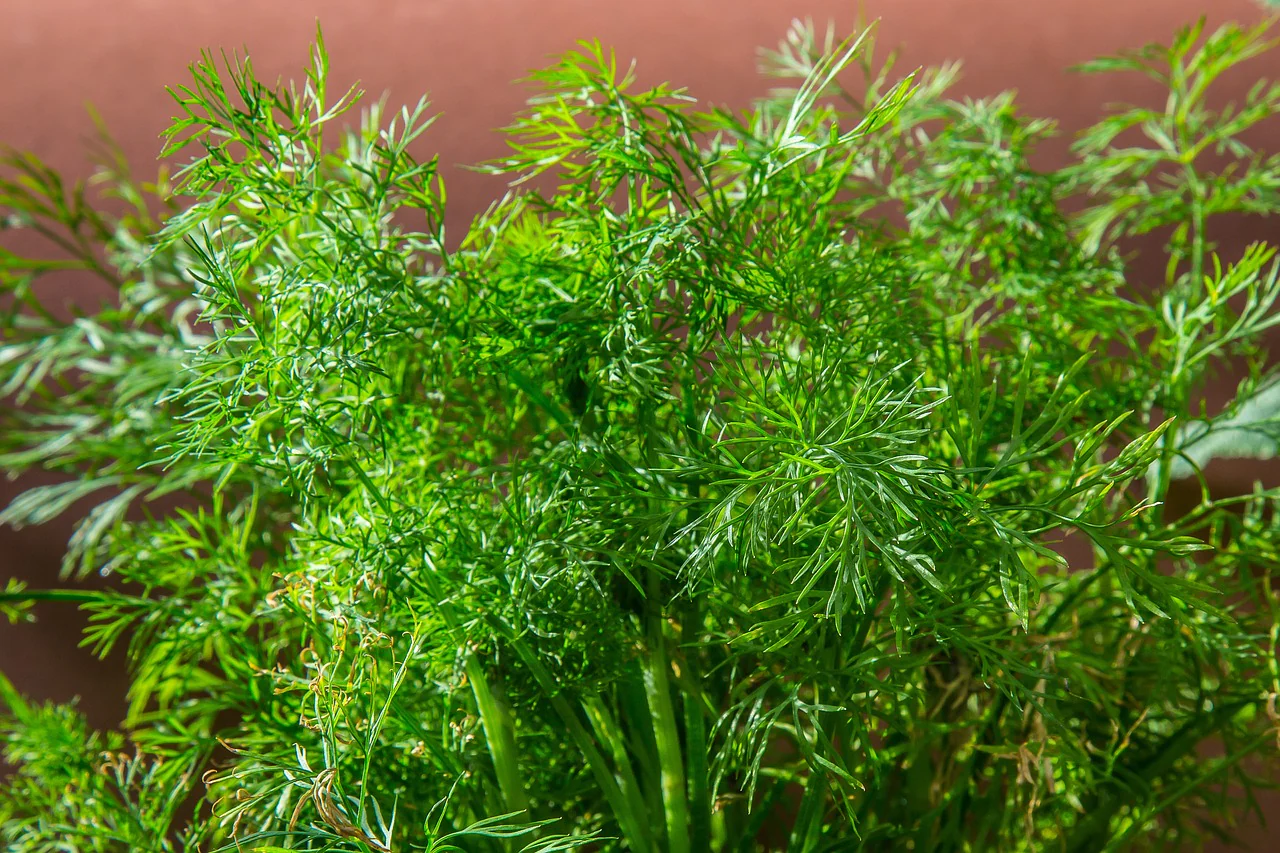
- Dukat dill is a particularly fine plant with amazing flavor and large heads. If you like dill you will love to try this new variety in your garden
- This variety is darker than most other dill varieties.
- Excellent fresh or dried.
- Grown for homemade dill pickles.
- Can be grown in containers, raised beds, and any other location in full sun.
- Annual plant.
- Adds great flavor and color to many culinary creations.
Additional Details
Dill has a very long history of herbal use going back more than 2,000 years. The seeds are a common and very effective household remedy for a wide range of digestive problems. An infusion is especially efficacious in treating gripe in babies and flatulence in young children. The seed is aromatic, carminative, mildly diuretic, galactogogue, stimulant and stomachic.
Other Medicinal Properties
Dill is also used in the form of an extracted essential oil. Used either in an infusion, or by eating the seed whole, the essential oil in the seed relieves intestinal spasms and griping, helping to settle colic. Chewing the seed improves bad breath. Dill is also a useful addition to cough, cold and flu remedies, it can be used with antispasmodics such as Viburnum opulus to relieve period pains. Dill will also help to increase the flow of milk in nursing mothers and will then be taken by the baby in the milk to help prevent colic.
See Dill Recipes & Growing Tips on our Pinterest Board
Follow SeedsNow.com's board Dill on Pinterest. - Dukat dill is a particularly fine plant with amazing flavor and large heads. If you like dill you will love to try this new variety in your garden
Spotted Bee Balm, Wild Bergamot Flowers
From $399 USDUnit price /UnavailableDescription

- The Spotted Bee Balm plant produces a beautiful plant with purple spotted flowers known to attract bees and other beneficial garden pollinators
- Common names: bee balm, horsemint, oswego tea, and wild bergamot
- Smell is similar to Thyme
- Has been used in teas and for other medicinal purposes
- This plant is drought tolerant. Grows well in dry conditions, requiring little water to grow
- Can grow up to 40" tall
- Perennial
- The Spotted Bee Balm plant produces a beautiful plant with purple spotted flowers known to attract bees and other beneficial garden pollinators
Sprouts/Microgreens - Chives, Garlic
From $499 USDUnit price /UnavailableDescription
Garlic Chives will produce shoots that grow to a mature height of roughly 12 inches tall. Popularly used to flavor potatoes and salads, Chives are not only tasty, but are also attractive as well. Each plant displays white colored flowers atop slender stems / shoots. Flowering much later than traditional Chives, it’s Garlic twins will bloom within the heat of the summer months. The shoots, once cut will add a slight garlic & onion flavor to any dish that they are added to. The flowers also add a mild onion/garlic flavor and can be used as a garnish.
Very easy to grow.
Country of Origin: Italy
Ready to consume after just a couple of days.
Sprouts/Microgreens - Beet, Dark Red
From $499 USDUnit price /UnavailableDescription
These Dark Red Beets grow into gorgeous, tender sprouts with deep red shoots and delicate green leaves. An amazing earthy flavor rounds out this extremely rewarding micro-green.
Beets can be the more difficult sprout to grow… but well worth it! It's the prettiest sprout there is (flame red) and can make any plate look and taste even better.
Beets like warm air 75 - 78 degree temperature, humidity 80 - 86%, water temperature 70 degrees) and low light in the room for the first 3 days. The outer surface of a beet seed is like a sponge and can absorb a great amount of water. Please read these instructions carefully:
Proper way to sprout Beet seed:
- Put beet seed in a bucket/tub/container
- Let the seeds soak in warm (not boiling and not cold) water for approx. 8 hours. Stir well in about 4 hours.
- Put in colander and Rinse with lukewarm water until the water that comes off is no longer brown.
⚠️ This is important, as red beet has the above water soluble anti-sprouting components (slime) on its hulls. This is a protection: otherwise, in nature, red beet would sprout in an environment that is not humid enough. Clever seed, isn’t it? - Set aside in a warm room. Give NO WATER and it will sprout in approx. 24-48 hrs.
- Then, water as you would any of your other sprouts & micro-greens
Happy planting!
Sprouts/Microgreens - Cilantro/Coriander Splits
From $499 USDUnit price /UnavailableDescription
We offer the highest quality cilantro micro green sprout seeds! These sprouts are a great ingredient to add to any dish for added flavor and nutrition. Sure to be your new favorite! Very easy to grow. Ready to consume after just a couple of days.
Sprouts/Microgreens - Chia, Black
From $499 USDUnit price /UnavailableDescription
Black chia microgreens are a nutrient-packed addition to your meals, offering a fresh, mild flavor and a satisfying crunch. Easy to grow and quick to harvest, these tiny sprouts deliver essential antioxidants, vitamins, and minerals that support overall wellness. Perfect for salads, sandwiches, and smoothies, black chia microgreens elevate your dishes with vibrant green color and a boost of natural energy. Incorporate them into your diet to enjoy a simple way to enhance both taste and nutrition.
Certified Organic Black Chia seeds.
Very easy to grow.
Ready to consume after just a couple of days.
Sprouts/Microgreens - Carrots (Micro)
From $499 USDUnit price /UnavailableDescription
Growing carrot microgreens and sprouts indoors is a rewarding way to enjoy fresh, nutritious greens year-round. Simply soak the seeds briefly, then spread them evenly on a clean, well-draining growing medium in a shallow tray. Keep the soil consistently moist and place the tray in a bright spot with indirect light or under a grow light for best results. Within just days, you’ll see vibrant sprouts ready to add a sweet, fresh flavor to your meals. Harvest microgreens in 10–14 days for a nutrient-packed boost that’s easy, convenient, and perfect for elevating your cooking at home.
Carrot microgreens require a fine, well-drained growing medium and consistent moisture to thrive. Sow seeds evenly on the surface and lightly cover them. Maintain temperatures between 60-75°F (15-24°C) and provide bright, indirect light once sprouts emerge to foster strong growth. Harvest when the first true leaves develop, cutting just above the soil line. These nutrient-rich microgreens offer a fresh, sweet carrot flavor, ideal for enhancing salads, sandwiches, and garnishes with a crisp, vibrant touch.
Carrot micro-greens are a new trend. And for good reason. They taste great and they are extremely nutritious.
Sprouts/Microgreens - Cabbage, Red
From $499 USDUnit price /UnavailableDescription
Cabbage red acre microgreens are beautiful, aren't they? Well, they taste as good as they look!
Very easy to grow.
Ready to consume after just a couple of days.
- From $499 USDUnit price /Unavailable
Description
Certified Organic. Arugula microgreens are the most popular. Chefs from all over the world utilize its crunchy tang in all kinds of salad dishes.
Very easy to grow.
Ready to consume after just a couple of days.
 LEARN MORE ABOUT THE SEED CLUB ➜
LEARN MORE ABOUT THE SEED CLUB ➜Looking for the perfect gift? 🎁✨
Sign someone up for the Urban Organic Gardener's Monthly Seed Club and receive a seed surprise all-year-round.
🌱 Featured Seed Types (A - Z)
View allcontinue shopping

























































































